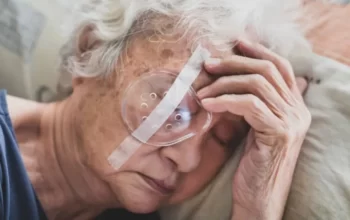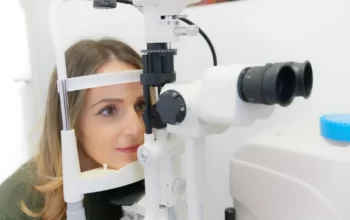
Blinking excessively is when you blink more frequently than usual. Both frequently and infrequently may occur. Although it also occurs in adults, it happens most frequently in children. What you need to know about blinking, including what causes it, how to stop blinking while taking pictures, and other serious conditions, is provided below.
Your body automatically blinks because it is a reflex. Whenever you want, you can force yourself to blink. Blinking too frequently is referred to as excessive blinking.
Excessive blinking isn’t exactly defined. When something interferes with your life, vision, or activities, it is typically regarded as excessive.
What Can Cause Excessive Blinking?
When your blinking reflex is overstimulated, you blink excessively. Both adults and kids can be impacted by the majority of these causes.
Eye Irritation
You may blink more than you’d like if you have irritation on the front surface of your eye, such as:
- eye irritants such as smoke, pollen (allergic reaction), pollution, chemical vapors, foreign object, or dust in the air
- dry eyes
- scratch on the outside of your eye (corneal abrasion) or other eye injury
- ingrown eyelash (trichiasis)
- pinkeye (conjunctivitis)
- inflammation of your iris (iritis)
- inflammation of your eyelid (blepharitis)
Eyestrain
Eyestrain is the result of focusing on one thing for an extended period of time. There are numerous factors that can strain the eyes. The most common reasons include:
- being in very bright light
- reading for a long time
- spending a long time in front of a computer
Vision Problems
The most common vision problems are easily fixed with corrective lenses and include:
- Myopia. Nearsightedness, particularly when wearing the incorrect corrective lenses.
- Hyperopia. Farsightedness, especially when wearing the wrong corrective lenses.
- Presbyopia. changes in the eyes caused by aging that affect near vision, which is needed for reading menus, newspapers, and books.
- Strabismus. when your eyes are not correctly positioned.
Movement Disorder (Eye Dystonia)
The most common eye movement disorders include:
- Blepharospasm that is not harmful. Rapid, uncontrollable blinking is brought on by eye muscle spasms.
- Meige syndrome. Spasms of the mouth and jaw are present along with blepharospasm.
Mental and Physical Health Issues
You may become more sensitive to light and experience eye strain when you’re under stress. General health conditions that may cause an increase in eye blinking include:
- Anxiety
- Stress
- Fatigue
Habit
Some people develop the habit of uncontrollably blinking excessively. After first beginning with one of the causes mentioned above (especially stress), it may eventually develop into a habit, but occasionally there isn’t a prior cause. Some individuals develop the nervous tic of eye blinking.

Best Tips to Stop the Blinking
1. To begin, make every effort to maintain your subject’s calm. Less stress means less blinking in photographs. Therefore, always consider your subject from their perspective. Not an object, but a human being, keep that in mind. Be friendly, outgoing, and compassionate.
2. Try to avoid super bright lighting. It causes squinting, which is unflattering, and increases blinking in photographs.
3. You should NEVER talk to your subject about how much they are blinking. When you have that conversation, you make the other person hyperaware of it, which causes them to focus on their blinking rather than unwinding and thinking pleasant thoughts.
4. Be sure to adjust your lighting if the subject you are photographing has delicate eyes. Don’t use the brightest lights that you can find. Raise your ISO, use softer lighting, be considerate of their predicament, and keep empathy in mind.
5. You will need to put in a little more effort if the subject you are photographing blinks nervously in anticipation of your flash. To prevent them from seeing my finger in this situation, I like to use a tripod and a wireless remote control. I also make it a point to vary my timing so that my shooting patterns are unpredictable.
When using this technique, conversation is crucial for promoting relaxation. In essence, I want them to ignore the camera. The more I can take the camera out of the equation — the less chance there is of them anticipating a shot due to nerves.
I know there are loads of articles and YouTube videos that recommend various solutions or “tricks”. Sadly, they ALL fail to understand the psychology and cause of the blinks.
Here are a few online examples I came across that, while they occasionally work, don’t always, and don’t actually solve the original issue. In fact, the majority of them only make matters worse.
- manipulating the target. Announcing that you’ll count to three before taking their photo on two.
- instructing your subject to count to three while purposefully blinking on two.
- When you take the picture, have the subject keep their eyes closed and open them on the count of three.
- Using TTL preflash with the assumption that they won’t actually flash when the pre-flash occurs.
- Using bounce flash.
- Telling the person to have “bright eyes” by explaining that the expression means to think of something that makes them smile with a hint of surprise, like seeing a child do something for the first time.
And there are many more of these “tricks” on the internet. Tricks are not a reliable way to stop blinking in photographs. As a result, the subject’s expression and body language are off because most of these tricks call for you to ask them to perform an action that has nothing to do with the emotional tone of the shot.
Work to relax your subject as a possible solution. Create a connection and express empathy. It will only get worse if you draw attention to the blinking issue. Use a tripod and wireless release to prevent your subject from anticipating the flash if they are a habitual blinker. Then, talk to them to divert their focus from the flash.
Facts About Blinking
Blinking is a reflex, which means your body does it automatically. Of course, you can force yourself to blink, but the majority of our blinking is reflexive and unconscious.
Blinking lubricates and cleans your eyes by spreading a cocktail of oils and mucous secretions over the surface of your eye. By shutting it off to debris, harsh light, and foreign objects, blinking also protects your eye from injury.
Babies and children only blink about two times per minute. When you are a teenager, that rises to 14 to 17 times per minute. For the rest of your life, it remains at that value.
You blink more when you’re talking, if you’re nervous, or in pain. When you read or feel potential danger, you blink less.
What Causes the Blinking in Photographs?
The majority of them are anticipation-based reflexes!
When you photograph the same subject repeatedly, they will grow accustomed to your finger moving toward the shutter, and when you press the button, their blink will be in response to your finger movement.
Even if they can’t see your finger, if you work and shoot in a particular rhythm, they may inadvertently pick it up and blink in anticipation.
Not only that, but a subject who is anxious or uncomfortable will blink more frequently, which emphasizes the importance of making your subjects comfortable and the necessity of communicating with them frequently while taking their pictures.
Serious Conditions That Can Cause Excessive Blinking
Excessive blinking has been linked to certain neurological conditions. It’s crucial to keep in mind, though, that the likelihood that your excessive blinking is a sign of a serious condition is extremely low.
- Wilson’s disease. Your body’s excess copper is the root of this ailment. Different organs receive the deposit, leading to various symptoms. In addition to excessive blinking, it can deposit in your brain and cause a number of neurologic symptoms. Clumsiness, grimacing, and tremors are a few examples of this.
- Multiple sclerosis. Your nervous system is impacted by this condition. Issues with vision, balance, coordination, and your ability to control your muscles are some additional symptoms in addition to excessive blinking.
- Tourette syndrome. Sudden, involuntary movements and vocal outbursts are symptoms of this condition. There may be excessive blinking if the muscle movement is in the area around the eye.
FAQs
Can You Blink in a Staring Contest
In order to prevail in a staring contest, you must maintain eye contact with your rival the entire time. In some variations of the challenge as well as not breaking eye contact you must not blink. The opponents in this variation must contend with both the physical discomfort and the psychological urge to turn their heads.
How to Not Blink When Putting in Contacts
It may be necessary to keep your eyelids open if you frequently blink or squeeze your eyes shut before inserting your contact lenses. If you need to, use two fingers, on one hand, to hold open the bottom and top eyelid, so you don’t blink. Be sure to widen your eyes. You want your eyelids to be as open as possible.
What Happens If I Don’t Blink for 5 Minutes?
The cornea may swell. Since your cornea lacks blood vessels, it relies on the tear film for oxygen, which it receives when you blink. Your cornea should still receive the oxygen it needs even if you simply blink less frequently. But if you don’t blink, the lack of oxygen can lead to corneal swelling.



